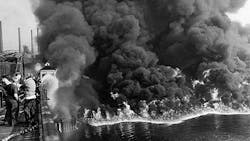SLC 2014: Implicit Safety – Rockwell Automation and the Future of Safe Tech
When the Cuyahoga River caught on fire near Cleveland in the late 1960s, it barely made the local news.
The river was polluted, debris-filled and disgusting. Everyone knew that. And everyone in the area knew that fires were an occasional consequence of it—fires had happened before and they would happen again. It was just a byproduct of business in the region.
But, as Mark Eitzman—Rockwell Automation's safety market development manager—noted in his presentation at EHS Today's Safety Leadership Conference today, that particular incident sparked something much bigger than just a trash fire.
"The story of the burning river got picked up by the ecology movement that was just growing at the time," he said. "In fact, it was really the spark the movement needed to make some dramatic changes in the industry."
Locally, he recalled, those changes began as an ecological technology race between two competing companies: Dow Chemical and DuPont.
Both companies were under pressure from the ecology movement in light of the fire, and began investing in new processes designed to specifically combat atmospheric discharge from their factories.
"They started putting in systems and technologies—some of which didn't even exist yet and had to be developed—to prevent discharge and pollution from their plants," he said.
Fifty years later, we can see the effect of that work both on the river and the technologies involved.
These companies cleaned up their shops, invented and invested in technologies to make work cleaner and safer. The river cleared up, the fires stopped and they set new standards for acceptable behaviors in their markets.
Those changes are permanent. Today, it is impossible to buy equipment without these technologies pre-installed. It's absurd to even consider setting up a plant without atmospheric emissions testing. It's illegal to try.
The legacy of the burning river, Eitzman said, is the development in inherently clean machines.
But then, he said, when we look at safety, the story doesn't quite translate.
Eitzman provided some startling statistics for comparison.
"Every 15 seconds," he said, "a worker dies from a work–related accident or disease. That's about 6,300 people every day. That's 2,300,000 people per year."
This, he said, is the next burning river the industry needs to take on.
"You can't buy a machine today that pollutes the environment like they did in the 60s," he said. "But you can buy a machine that can kill someone. You can buy a machine that has designs on it that can kill someone in your plant, cut their hands off, critically injure them."
Shoring that up, he said, is the next step in safety technology.
"Five-to-ten years from now, I hope, you won't be able to buy these anymore," he said. "You won't be able to buy them because no one will make one. No one will make one because no one will want to buy one. "
That is a good target, of course. And it makes sense. But it relies on companies to look beyond the simple numbers of their day to day business, he explained, and take a good look at safety in their manufacturing processes.
That requires debunking a longstanding myth in the industry the safety only comes at the expense of productivity. That is something, he argued, that top companies are already proving wrong.
Again, he points to the burning river as an example.
"[Dow and DuPont] improved emissions," Eitzman said, "But they also found that their productivity and OEE skyrocketed in the process."
Suddenly, he said, they didn't have to shut down for maintenance as often. The machines were running cleaner. Their workers were in better condition. The technologies made the work environment not cleaner and safer, they discovered, it was also better for their bottom lines.
"Safety," he said, "is good business."
That lesson really provided the foundation for a lot of the work happening in the safety world today. The efforts of Rockwell Automation and other safety technology makers is to locate the key merger points between safety, productivity and efficiency, and finding the innovations and internal changes that can move them all in the right direction.
The future of manufacturing technology, he said, will help enable that merger.
To help make that clear, Rockwell has developed a Safety Maturity Index, which provides a yardstick for companies' path along this course. For more, see: Safety Maturity: Three Crucial Elements of Best-in-Class Safety.
